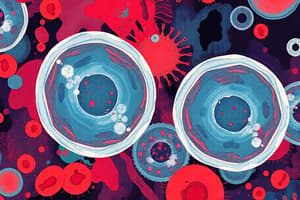Podcast
Questions and Answers
What is the primary cause of granulocyte (neutrophil) increase in leukophilia?
What is the primary cause of granulocyte (neutrophil) increase in leukophilia?
- Direct infection of granulocytes
- Increased bone marrow production of leukocytes
- Increased extravasation into tissues
- Decreased margination due to catecholamines (correct)
Which condition is most likely associated with lymphocytosis?
Which condition is most likely associated with lymphocytosis?
- Drug toxicity
- Viral infections (correct)
- Ineffective erythropoiesis
- Auto-immune disorders
Which type of hyperplasia is characterized by the proliferation of B-cells in germinal centers?
Which type of hyperplasia is characterized by the proliferation of B-cells in germinal centers?
- Chronic non-specific lymphadenitis
- Acute lymphadenitis (correct)
- Follicular hyperplasia
- Nodular lymphoid hyperplasia
What type of mutations primarily drive the proliferation of hematologic malignancies?
What type of mutations primarily drive the proliferation of hematologic malignancies?
Which of the following is a likely result of overwhelming infection regarding leukocyte levels?
Which of the following is a likely result of overwhelming infection regarding leukocyte levels?
Which chromosomal alteration is specifically associated with Chronic Myelogenous Leukemia?
Which chromosomal alteration is specifically associated with Chronic Myelogenous Leukemia?
What common presentation is associated with Acute Lymphoblastic Leukemia in children?
What common presentation is associated with Acute Lymphoblastic Leukemia in children?
Which of the following is NOT classified under Non-Hodgkin's lymphoma?
Which of the following is NOT classified under Non-Hodgkin's lymphoma?
Which genetic factor is commonly associated with Myelodysplasia?
Which genetic factor is commonly associated with Myelodysplasia?
What type of leukemia is characterized by chromosomal aberrations and differentiation issues?
What type of leukemia is characterized by chromosomal aberrations and differentiation issues?
Flashcards
Leukophilia
Leukophilia
Increased number of white blood cells in the blood, often due to inflammation or infection.
Leukopenia
Leukopenia
A decrease in the number of white blood cells in the blood, possibly caused by immune disorders, drug reactions, or bone marrow diseases.
Lymphocytosis
Lymphocytosis
An increase in the number of lymphocytes, particularly in response to viral infections, such as mononucleosis.
Lymphopenia
Lymphopenia
Signup and view all the flashcards
Lymphoid Hyperplasia
Lymphoid Hyperplasia
Signup and view all the flashcards
Acute Lymphoblastic Leukemia (ALL) - B-Cell
Acute Lymphoblastic Leukemia (ALL) - B-Cell
Signup and view all the flashcards
Non-Hodgkin's Lymphoma (NHL)
Non-Hodgkin's Lymphoma (NHL)
Signup and view all the flashcards
Hodgkin's Lymphoma
Hodgkin's Lymphoma
Signup and view all the flashcards
Multiple Myeloma
Multiple Myeloma
Signup and view all the flashcards
Acute Myelogenous Leukemia (AML)
Acute Myelogenous Leukemia (AML)
Signup and view all the flashcards
Study Notes
Abnormalities of White Blood Cells
- White blood cell abnormalities are characterized by reactive changes in granulocytes and lymphocytes, as well as neoplastic changes.
- Leukocyte, platelet, and red blood cell production originate from hematopoietic stem cells and colony-forming units.
- Common malignancies affect lymphocyte precursors, more mature lymphocytes, and chronic leukemias.
- Methods to identify hematopoietic cells rely on cell surface antigens.
- Immunoglobulin production and multiple myeloma development are also critical aspects of this topic.
Objectives
- Reactive changes in granulocytes and lymph node morphology are contrasted with neoplastic alterations.
- Leukocyte, platelet, and red blood cell production processes using hematopoietic stem cells and colony-forming units are reviewed.
- Common malignancies affecting lymphocyte precursors, more mature lymphocytes, and chronic leukemias are identified.
- Identifying methods for hematopoietic cell (surface antigen) identification are detailed.
- Immunoglobulin production and multiple myeloma development are examined.
Cell Lineage Development
- Hematopoietic stem cells differentiate into multipotent progenitors.
- These progenitors further differentiate into early progenitors with either lymphoid or myeloid potential, leading to various mature blood cell types.
- Lymphopoiesis, the development of lymphocytes, is detailed.
- Myelopoiesis, the development of myeloid cells, is illustrated, showing different types of granulocytes and monocytes.
Monoclonal Antibodies and Cellular Distribution
- Various monoclonal antibodies (with associated designations like CD1, CD3, CD4, CD8, and others) target specific antigens and are used to identify different types of white blood cells or precursors.
- Information on normal cellular distribution is provided using these markers associated with various cells and blood cell lineages.
Leukopenia/Leukophilia
- Increased leukocytes (leukophilia) are often associated with inflammation, infection, TNF, IL-1, and decreased margination/extravasation of granulocytes.
- Reduced leukocytes (leukopenia) are often linked to auto-immune diseases, drug toxicity, bone marrow diseases, ineffective erythropoiesis, and overwhelming viral infections like HIV.
The Lymph Node
- Structure of the lymph node is examined, including the secondary and primary lymphoid follicles, paracortex, medullary cords, sinuses, and lymphatic vessels.
Lymphoid Hyperplasia
- Acute lymphadenitis involves B-cell proliferation within germinal centers.
- Chronic non-specific lymphadenitis showcases follicular hyperplasia.
Lymphoid Neoplasms (Classification)
- Various lymphoma types are categorized based on precursor B or T cells and other factors, including specific examples like B-cell acute lymphoblastic leukemia (B-ALL), different subtypes of chronic lymphocytic leukemia or lymphoma, and various T-cell pathologies.
Hematologic Malignancies
- Genetic mutations regulating cell differentiation (stem cell conversion), proliferation (MCY, RAS), and apoptosis prevention are key aspects of hematological malignancies.
Precursor B-Cell Malignancy
- Acute lymphoblastic leukemia (ALL) is often the most prevalent early childhood malignancy, typically presenting with symptoms like bleeding, infections, and organ involvement.
- Chronic lymphocytic leukemia emphasizes the importance of chromosomal abnormalities as a crucial factor.
- Lymphoma types (e.g., chronic lymphocytic leukemia, follicular lymphoma, diffuse large B-cell lymphoma) are described.
Acute Lymphoblastic Leukemia
- Morphology and immunophenotyping data are included, particularly related to CD22, CD19, and CD10 positive cells.
Non-Hodgkin's Lymphomas
- The different types of B-cell (e.g., follicular, diffuse large B-cell, mantle cell, Burkitt's) and T-cell malignancies are catalogued (e.g. large cell lymphoma, Mycosis Fungoides, Sezary syndrome, NK cell leukemia).
Hodgkin's Lymphoma
- Distinct subtypes like nodular sclerosis, mixed cellularity, lymphocyte-rich, lymphocyte depletion, and lymphocyte predominance are identified based notably on the presence of Reed-Sternberg cells.
Multiple Myeloma/Plasmacytoma
- The pathology of multiple myeloma/plasmacytoma is discussed.
Immunoglobulins
- Immunoglobulin class (IgG, IgM, IgA, IgD, IgE) and subclasses (IgG1-4), levels, presence in secretions, activation and transfer properties are details. This also includes their structural complexity and function.
Chronic Myelogenous Leukemia
- BCR-ABL translocation, a crucial characteristic, is identified as a key factor.
Acute Myelogenous Leukemia (AML)
- AML involves chromosomal aberrations, specifically those impacting differentiating genes and epigenetic modifications. Myelodysplasia, characterized by maturation defects and ineffective erythropoiesis, and the role of chromosomal defects, transcription factor issues, and p53 loss are detailed.
Studying That Suits You
Use AI to generate personalized quizzes and flashcards to suit your learning preferences.




